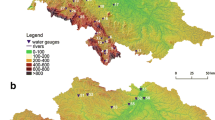Abstract
A technique for automatic computation of circulatory shunts from indicator-difution curves is presented. In the case of shunts, dilution curves over the heart and pulmonary circulation comprise two primary curves occasionally with a marked, mutual overlap Quantitative determination of a right to left or left to-right shunt is based on a mathematical spearation of the shunt-dilution curve into the component primary curves. A mathematical model of the bimodal distribution of indicator transit times has been fitted directly to a complete shunt-dilution curve. This model is based on a local-density random-walk approach. Validation of the model is performed by simulations of shunt-dilution curves both mathematically and with a hydrodynamic circulation model. Analysis of the curves. Shows that the technique presented provides reliable and accurate estimates of the amount of shunt even in cases of marked overlap of the primary curves, in which the techniques usually applied are inaccurate or inadequate. This conclusion is confirmed in animal experiments in which we have estimated right-to-left shunts through the torament ovale of newborn pigs
Similar content being viewed by others
References
Berman, M., Shahn, E. andWeiss, M. F. (1962) The routine fitting of kinetic data to models: a mathematical formalism for digital computers.Biophysical J.,2, 275–287.
Bogaard, J. M. (1980), Interpretation of indicator-dilution curves with a random walk model. Thesis Erasmus University, Rotterdam, The Netherlands (with summary in English).
Bogaard, J. M., Smith, S. J., Versprille, A., Wise, M. E. andHagemeijer, F. (1984) Physiological interpretation of the skewness of indicator-dilution curves; theoretical considerations and a practical application.Basic Res. Cardiol. (in press).
Jansen, J. R. C., Bogaard, J. M., Spritzer, R., Verbraak, A. F. M. andVersprille, A. (1982) {csAutomatic analysis of circulatory shunts under circumstances of artificial ventilation}. InComputers in critical care and pulmonary medicine, Vol. 2,Prakash, O. (Ed.), Plenum Press, New York, 219–221.
Krovetz, L. J. (1979) Automated computation of cardiac output and shunts from indicator dilution curves.IEEE Trans.,BME-26, 117–119.
Kuikka, J., Lehtovirta, P., Kuikka, E. andRekonen, A. (1974) Application of the modified gamma function to the calculation of cardio-pulmonary blood pools in radiocardiography.Phys. Med. Biol.,19, 692–700.
Messerli, F. H., De Sepibus, G., Weber, J. W. andGurtner, H. P. (1974) Quantitative Evaluation des links-rechts-Shunts mit Farbstoffverdünnungsmethoden.Z. Kardiol.,63, 560–573.
Mook, G. A. andZijlstra, W. G. (1961) Quantitative evaluation. of intracardiac shunts from arterial, dye-dilution curves; demonstration of very small shunts.Acta Med. Scand.,170, 703–715.
Norwich, K. H. andZelin, S. (1970) The dispersion of indicator in the cardio pulmonary system.Bull. Math. Biophys.,32, 25–43.
Oeseburg, B., Meyer, E., Stutterheim, J. andZijlstra, W. G. (1969) Quantitative evaluation of circulatory left-to-right shunts by ascorbinate dilution using a single venous catheter for injection and measurement.Cardiovasc. Res.,3, 235–240.
Schreuder, J. J., Jansen, J. R. C., Bogaard, J. M. andVersprille, A. (1982) Hemodynamic effects of positive endexpiratory pressure applied as ramp.J. Appl. Physiol.: Respirat. Environ. Exercise,53, 1239–1247.
Smith, S. J., Bogaard, J. M., Hagemeijer, F., Rijkmans, H. J. D., Bos, G. andHesse, C. J. (1981) Pulmonary edema in man: comparison of capillary filtration pressure, quantification by means of the double indicator-dilution method, and clinical observations.Eur. Heart J.,2, 109–116.
Spritzer, R., Versprille, A., Bogaard, J. M., Verbraak, A. F. M. andJansen, J. R. C., (1981) Effect of intermittent and continuous positive pressure ventilation on the haemodynamics of the central circulation.Pediatric Res.,15, 1219.
Uhrenholdt, A., Rygg, I. andEngell, H. C. (1967) Pre- and post-operative dye dilution curves in operations for intra-cardiac and pulmonary shunts.Scan. J. Thor. Cardiovasc. Surg.,1, 151–160.
von Reth, E. A. andBogaard, J. M. (1983) Comparison of a twocompartment model and distributed models for indicator dilution studies.Med. & Biol. Eng. & Comput.,21, 453–459.
von Reth, E. A., Aerts, J. C. J., van Steenhoven, A. A. andVersprille, A. (1983) Model studies on the influence of nonstationary flow on the mean flow estimate with the indicator dilution technique.J. Biomech.,16, 625–635.
Wise, M. E. (1966a) Tracer-dilution curves in cardiology and random walk and log-normal distributions.Acta Physiol. Pharmacol. Neerl.,14, 175–204.
Wise, M. E. (1966b) The geometry of log-normal and related distributions and an application to tracer-dilution curves.Stat. Neerl.,20, 119–142.
Author information
Authors and Affiliations
Rights and permissions
About this article
Cite this article
Marinus, J.L.M., Massen, C.H., van Reth, E.A. et al. Interpretation of circulatory shunt-dilution curves as bimodal distribution functions. Med. Biol. Eng. Comput. 22, 326–332 (1984). https://doi.org/10.1007/BF02442101
Received:
Accepted:
Issue Date:
DOI: https://doi.org/10.1007/BF02442101




